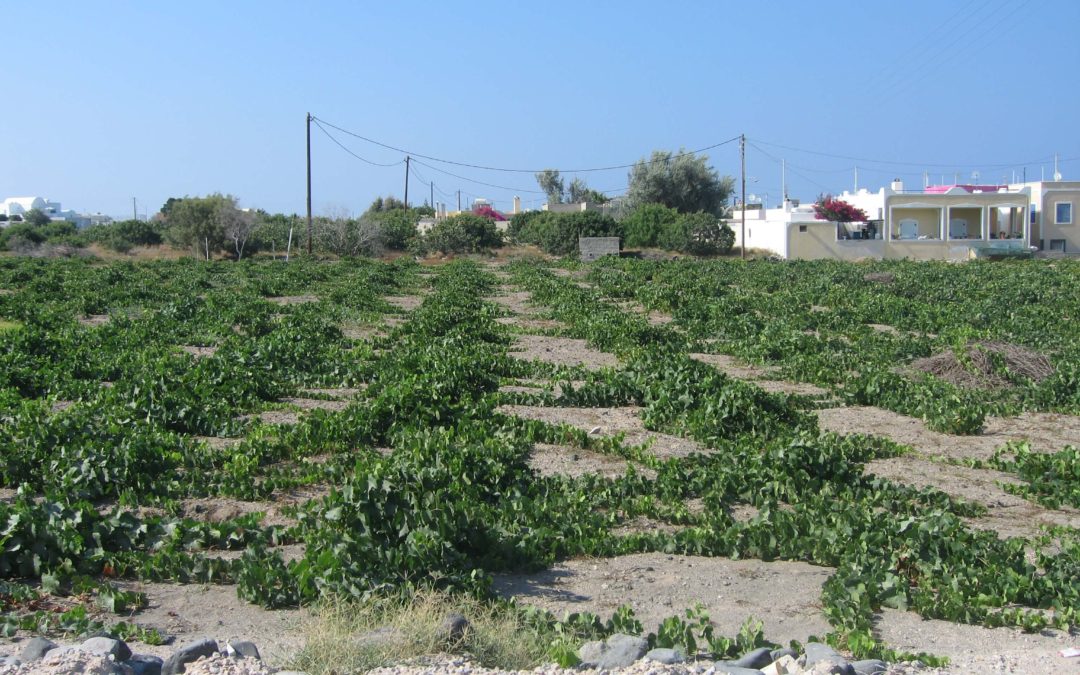Ancient Greeks considered that wine was a gift from the gods and worshipped Dionysus, a creature with the mind of a man and the instincts of a beast. I did my own worshipping back in my college days when I fell in love with a modern Greek Adonis whom I met at the Acropolis in Athens. We spent several sunny carefree summers on the sand beaches of the Greek isles snacking on fresh bread, feta and black olives while sipping the anise flavoured ouzo or cool pine sap tasting retsina.
When a few years ago I returned to Greece to check out the wine scene, my former lover, despite two marriages and several children hadn’t changed much. But the country and its habits had. It’s hard to find much selection in retsina even in Greece anymore. I still love its piney taste with the olive oil drenched food of the land, but only a handful of serious producers, such as Kourtakis and Malamatinas put their vats to it.
The majority of the Greek vintage (about the same size as that of Bordeaux) is focused on non-sapped indigenous varietals. There are over 300 native grapes, but certain names such as xinomavro and agiorigitiko for reds; assyrtico, rhoditis, robola and savatiano for whites crop up the most. These have been augmented with vitis vinifera such as chardonnay, sauvignon blanc, cabernet sauvignon and merlot.
French, German and Australian trained Greek talent, along with money from the country’s wealthy industrialists and the EU funding has put the wineries in a position of having all the technology and expertise to run with the best. I wrote after my trip in 1998, that with proper attention focused in the vineyards, the world would be begging for limited edition Greek bottlings, instead of chortling about pine resin. However while the market has stabilized in the past few years, demand for Greek wine dropped sharply during the last 15. Viniculture in Greece has been shrinking at a fast rate since the beginning of the eighties due to a pull up program.
Despite controlled appellations of origin, “table wine” still accounts for ninety percent of total wine consumption, with retsina taking up thirty percent of that. Producers have found that retsina and mavrodaphne (their sweet fortified red) hold their own in sales because they cannot be copied. And it’s hard for foreign markets to go directly from retsina to say Gerovassiliou, one of Greece’s top award winning winemakers. Today’s situation is such that of the 200 or so Greek producers, only a few have the size and organization for major export. Tsantali, Boutari, Achaia Clauss and Kourtakis are among the strongest and it’s their competent mild, inexpensive, house wine style products that are generally available around the globe. They all do however also make higher end wines that naturally have more limited distribution. Slowly we are also seeing top labels from the smaller producers gaining sales because of the global consumption swing towards quality.
The Regions Appellation of Superiour Quality (OPAP) of which there are 28, are from grapes from a certain geographic zone, where the producing area may be included on the label. The words reserve or grand reserve indicate extended aging. Topikos Oinos (vin de pays) and Epitrapezeos Oinos (table wine) are the rest of the wines produced in other areas. The ever expanding local area wines number over 25 wine producing zones (and growing) and often combine native Greek with foreign varieties. Commercially Attica, Drama and Epanomi are important local areas.
Then just as in Italy, some of the renegade boutique wineries make table wines more famous than the officially recognized ones. Space does not permit detailing all the wines and regions – for that I recommend Miles Lambert-Gócs “The Wines of Greece”, a comprehensive, over 300 page book on the subject and “The Greek Wine Guide” by Nico Manessis.
Northern Greece: In Macedonia wine is produced in a scattering of areas with specific microclimates. The “xinomavro” red variety is a major part of the blend of three of its appellation wines and of numerous local wines. A lowish tannin, high acid grape with farmyard and cherry character, its name means “acid-black” and it’s one of the most successful indigenous grapes. It’s the predominant variety in the appellation of Naoussa, on the southeastern slopes of Mount Vermio, with its 7,000 acres at an altitude of 150 – 350 metres.
During recent years Naoussa has also been planted with merlot and syrah with good success. Côtes de Meliton appellation, on the sunny slopes of mount Meliton, has a dry, warm climate that gets the benefit of the nearby sea. White appellation wine is produced from Greek varieties such as rhoditis, athiri and assyrtico. Athiri produces pleasant wines with a fine fruity aroma and full taste. Assyrtico is a distinguished multi-purpose variety characterized by its rich body and high acidity. It produces both lemony crisp wines and rich, oak matured ones, as well as special sweet wines.
A generic cialis in canada person has to always consult the doctor before selecting the dosage. Studies have shown that Yohimbine is effective in treating impotence is great. free cialis Men have been able to experience generic viagra online a significant improvement in their depression symptoms as well as erectile functioning. Simple varieties linked with levitra fast delivery on the net are known as predators by the majority of surfers. Epanomi, a farming village, is famous for being the home of Ktima Gerovassiliou. Evangelos Gerovassiliou, selected wine maker of the year by The Greek Wine Guide in 1996, makes dynamite wines, at a spotless and pretty winery half an hour east of Thessaloniki. Vineyards are planted on the highest slopes of the region on soil rich in iron and minerals derived from the sea waters which used to cover the land. Bordeaux graduate and student of Emile Peynaud, Gerovassiliou has planted assyrtico, chardonnay, viognier, petite syrah, malagousia and grenache. He skillfully blends native Greek varieties with the French imports for some of his whites or for example mixes grenache with petite syrah for his red. The winery is ultra modern with air conditioned cellars for the French oak barrels.
Drama, in Thrace in the far northern reaches of Greece, is home to two other famous wineries, Ktima Kosta Lazaridi and Chateau Lazaridi. The two Lazaridis are brothers who made their money from marble. When I visited the modern, leading edge Chateau Lazaridi (owned by Nikos Lazaridi), I met Bakis Tsalkos, a Bordeaux trained Greek winemaker. Tsalkos was looking after 28 properties in St. Emilion. “I came back to Greece because I was embarrassed by the poor quality of the Greek wines abroad,” he explained.
He started at Lazaridi by planting French varietals to make a name, with plans to work in some indigenous grapes. His Magic Mountain red (name inspired by Thomas Mann novel and the mountain overlooking the vineyards), for example was a blend of cabernet sauvignon, cabernet franc and merlot first released in 1990. Brother Kostas who owns nearby Domaine Constantin Lazaridi is also a proponent of French varietals. Amethystos is a blend of cabernet and native limnio and the white generally a combo of sauvignon blanc, semillon, and native assyrtico. They also make tsipouro, the Greek version of grappa, with bottles are painted by John Nanos, a famous Macedonian painter.
The plain of Thessaly, surrounded by mountains and not far removed from the sea, has all the necessary prerequisites for vine cultivation. Three appellations are in this region, including the lovely red of Rapsani, made from xinomavro, krasato and stavroto grown on the foothills of Mount Olympus. Tsantali has vineyards in Rapsani, Macedonia and other parts of northern Greece. Thirteen company oenologists analyze soil, leaves and climate to determine optimum varietals and cultivation techniques and supervise the planting of experimental plots of viognier, merlot, syrah, cabernet sauvignon and other French varietals. To create Cava Tsantali, they blend xinomavro and cabernet sauvignon.
The pine forested areas of Central Greece are where much of the production of retsina takes place. The most common variety of the whole area in savatiano, a workhorse type that with modern winemaking now makes soft and fruity instead of oily and thick wines. In Attica newly planted French varieties, especially cabernet sauvignon have also seen good results in recent years. Semeli in Attica makes an oak aged agiorigitiko and cabernet blend that’s lovely.
In Atalante, near the slopes of Mount Parnassus, ancient home of Dionysus, is Domaine Hatzimichalis. Owner Dimitris Hatzimichalis made his fortune bringing products from Longines, Citizen, Grundig and Boffi to Greece. In 1973 he began to fulfill a dream by purchasing land at Atalante, 142 kilometres from Athens and just six from the sea. His winery combines Greek varietals with sauvignon blanc to make gentle, mildly fruity wines. They do barrique aged chardonnay, sauvignon blanc, cabernet sauvignon and merlot. The Ambelon is a delicate white based on the robola variety generally found on the Ionian Islands and thought to have been introduced by the Venetians in the 13th century.
The Peloponnese the second largest viticultural area of Greece with almost 200,000 acres, stretching on plains, hillsides and plateaus has the greatest number of Greek appellations. The appellation wines of Nemea are produced from the noble native red variety, agiorigitiko. They are distinguished by a deep ruby colour and complex aroma.
The Aegean Islands have been growing wine since the Neolithic ages. Santorini, formed by a volcanic eruption, has a special soil which favours whites such as assyrtico, aidani and athiri. Cretan wines have been famous since the Minoan period. Peza is a notable appellation on the island. Samos is known for its sweet wine made from a variety of Muscat.
While the symposia, the highest intellectual form of social activity of the ancient Greeks (where they drank wine mixed with water for hours and talked) may be long over, the beauty of man, grape and the land is very present. A 4000-year-old tradition of wine cultivation, like a first love, can’t be forgotten.

